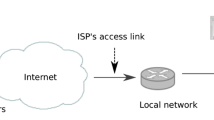Abstract
Network traffic processing is an automated method for arranging and optimizing network traffic, based on the parameters. The traffic data is gathered to begin the study of the component of network traffic. Subsequently, the clustering and grouping process is carried out to evaluate network traffic. Continuous evaluation of the patterns of network traffic remained a daunting challenge during traffic classification. However, existing approaches have not been able to reduce time consumption and improve clustering accuracy for network traffic analysis. In order to resolve these problems, a Density-based Mean Shift Clustering and Deep Packet Inspection Classification (DMSC-DPIC) methodology is implemented to perform an efficient network traffic analysis. In addition, the classification model DPI has been developed to identify network Traffic by payloading data points with minimum time as real as well as non-real-time traffic. In the DPI classification model, data points are grouped into various groups by analyzing associated points throughout the session. The experimental assessment of the proposed methodology DMSC-DPIC is carried out with the CAIDA anonymized Internet Traces Dataset and achieves improved efficiency compared with state-of-the-art work in terms of clustering precision, classification time and communications overhead.






Similar content being viewed by others
References
Luigi Grimaudo; Marco Mellia; Elena Baralis & Ram Keralapura, . (2014). SeLeCT: Self-Learning Classifier for Internet Traffic. IEEE Transactions on Network and Service Management, 11(2), 144–157.
Zhang, J., Yang Xiang, Yu., Wang, W. Z., Xiang, Y., & Guan, Y. (2013). Network Traffic Classification Using Correlation Information. IEEE Transactions on Parallel and Distributed Systems, 24(1), 104–117.
Jun Zhang, Xiao Chen, Yang Xiang, Wanlei Zhou, & Jie Wu (2015). Robust Network Traffic Classification. IEEE/ACM Transactions on Networking, 23 (4), 1257–1270.
Alok Tongaonkar, Ruben Torres, Marios Iliofotou, Ram Keralapura & Antonio Nucci (2015). Towards self-adaptive network traffic classification. Computer Communications, 56, 35–46.
Stefania Tosi, Sara Casolar & Michele Colajanni. (2013). Data clustering based on correlation analysis applied to highly variable domains. Computer Networks, 57, 3025–3038.
Jiawen Wang, Yinsong Wang. (2014). Meiping Yun and Xiaoguang Yang, Development of Urban Road Network Traffic State Dynamic Estimation Method, Hindawi Publishing Corporation. Mathematical Problems in Engineering, 2015, pp 1–10.
Ying-Dar Lin, Po-Ching Lin, Sheng-Hao Wang, I-Wei Chen & Yuan-Cheng Lai (2016). PCAPLib: A System of Extracting, Classifying, and Anonymizing Real Packet Traces, IEEE Systems Journal, 10 (2), 520 – 531.
Yanjie Fu, Hui Xiong, Xinjiang Lu,; Jin Yang & Can Chen (2016). Service Usage Classification with Encrypted Internet Traffic in Mobile Messaging Apps.IEEE Transactions on Mobile Computing,15 (11), 2851–2864.
Yasser Yasami & Saadat Pour Mozaffari. (2010). A novel unsupervised classification approach for network anomaly detection by k-Means clustering and ID3 decision tree learning methods, The Journal of Supercomputing, 53 (1), 231–245.
Xiangrong Zhang, Licheng Jiao, Anand Paul, Yongfu Yuan, Zhengli Wei & Qiang Song (2014). Semisupervised particle swarm optimization for classification. Hindawi Publishing Corporation, Mathematical Problems in Engineering, Volume 2014, 1–11.
Udendhran, R., Balamurugan, M., Suresh, A., & Varatharajan, R. (2020). Enhancing image processing architecture using deep learning for embedded vision systems. Microprocessors and Microsystems, Volume 76, 2020, 103094. ISSN 0141–9331. https://doi.org/10.1016/j.micpro.2020.103094 .
Udendhran, R., & Balamurugan, M. (2020). Towards secure deep learning architecture for smart farming-based applications. Complex & Intelligent Systems, 1–8,. https://doi.org/10.1007/s40747-020-00225-5.
Bakhshi, T., Ghita, B., & Classification, O. I. T. (2016). A two-phased machine learning approach, Hindawi Publishing Corporation. Journal of Computer Networks and Communications, 2016, 1–21.
Mohiuddin Ahmed & Abdun Naser Mahmood. (2015). Novel approach for network traffic pattern analysis using clustering-based collective anomaly detection. Annals of Data Science, 2 (1), 111–130.
Egea, S., Gomez, Belen CarroMartõnez, Antonio J. Sanchez-Esguevillas & Luis Hernandez-Callejo. (2017). Ensemble network traffic classification: Algorithm Comparison and novel ensemble scheme proposal. Computer Networks, 127 (9), 68–80.
Paweł Foremski, Christian Callegari & Michele Pagano (2017). Waterfall traffic classification: A quick approach to optimizing cascade classifiers. Wireless Personal Communications, Springer, 96 (4), 5467–5482.
Lin Guan-Zhou, Xin Yang, NiuXin-Xin & Jiang Hui-bai. (2010). Network traffic classification based on semi-supervised clustering. The Journal of China Universities of Posts and Telecommunications, 17 (2), 84–88.
Jose Camacho, Pablo Padilla, Pedro García-Teodoro & Jesús Díaz-Verdejo (2013). A generalizable dynamic flow pairing method for traffic classification. Computer Networks, 57 (14) 2718–2732.
Funding
All sources of funding for the research work and their role in the design of the study and collection, analysis, interpretation of data, and in writing the manuscript should be declared.
Author information
Authors and Affiliations
Corresponding author
Ethics declarations
Conflict of interest
The authors declare that they have no conflict of interest. The manuscript was written through contributions of all authors. All authors have given approval to the final version of the manuscript.
Additional information
Publisher's Note
Springer Nature remains neutral with regard to jurisdictional claims in published maps and institutional affiliations.
Rights and permissions
About this article
Cite this article
Kumar, S.A.P., Suresh, A., Anand, S.R. et al. Hybridization of Mean Shift Clustering and Deep Packet Inspected Classification for Network Traffic Analysis. Wireless Pers Commun 127, 217–233 (2022). https://doi.org/10.1007/s11277-021-08208-6
Accepted:
Published:
Issue Date:
DOI: https://doi.org/10.1007/s11277-021-08208-6




